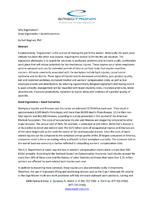IPC Releases PCB Industry Results for January 2014.
Share:
Press Release Summary:
As announced by IPC concerning January 2014 findings from monthly North American PCB Statistical Program, PCB sales and orders were below January 2013 levels. Book-to-bill ratio continues climbing but remains below parity at 0.95. Total North American PCB shipments decreased 7.5% from January 2013, and bookings came in at 3.7% below same month last year. Compared to December 2013, sales were down 16.9% and bookings were down 7.0% as based on same sample of reporting companies.
Original Press Release:
North American PCB Industry Book-to-Bill Ratio Improves, but Sales Continue to Lag
IPC Releases PCB Industry Results for January 2014
BANNOCKBURN, Ill., USA — IPC — Association Connecting Electronics Industries® announced today the January findings from its monthly North American Printed Circuit Board (PCB) Statistical Program. January PCB sales and orders were below the levels of January 2013. The book-to-bill ratio in January continued climbing, but remains below parity at 0.95.
Slow Start to 2014
Total North American PCB shipments decreased 7.5 percent in January 2014 from January 2013, while bookings came in at 3.7 percent below the same month last year. Compared to December 2013, January sales were down 16.9 percent and bookings were 7.0 percent below the prior month, based on the same sample of reporting companies.
“January is typically a slow month in electronics manufacturing, especially compared to December, but this winter the industry may also be feeling the effects of weather-related slowdowns,” said Sharon Starr, IPC’s director of market research. “The good news is that the book-to-bill ratio continued to climb in January,” she added.
Detailed Data Available
The January edition of IPC’s North American PCB Market Report, containing detailed January data from IPC’s PCB Statistical Program, will be published by March 10. The monthly report presents detailed findings on rigid PCB and flexible circuit sales and orders, including separate rigid and flex book-to-bill ratios, military and medical market growth, demand for prototypes, and other timely data. This report is available free to current participants in IPC’s PCB Statistical Program and by subscription to others. More information about this report can be found at www.ipc.org/market-research-reports.
Interpreting the Data
The book-to-bill ratios are calculated by dividing the value of orders booked over the past three months by the value of sales billed during the same period from companies in IPC’s survey sample. A ratio of more than 1.00 suggests that current demand is ahead of supply, which is a positive indicator for sales growth over the next three to six months. A ratio of less than 1.00 indicates the reverse.
Year-on-year and year-to-date growth rates provide the most meaningful view of industry growth. Month-to-month comparisons should be made with caution as they reflect seasonal effects and short-term volatility. Because bookings tend to be more volatile than shipments, changes in the book-to-bill ratios from month to month may not be significant unless a trend of more than three consecutive months is apparent. It is also important to consider changes in bookings and shipments to understand what is driving changes in the book-to-bill ratio.
IPC’s monthly PCB industry statistics are based on data provided by a representative sample of both rigid PCB and flexible circuit manufacturers selling in the USA and Canada. IPC publishes the PCB book-to-bill ratio at the end of each month. Statistics for the current month are not available until the last week of the following month.
About IPC
IPC (www.IPC.org) is a global industry association based in Bannockburn, Ill., dedicated to the competitive excellence and financial success of its 3,400 member companies which represent all facets of the electronics industry, including design, printed board manufacturing, electronics assembly and test. As a member-driven organization and leading source for industry standards, training, market research and public policy advocacy, IPC supports programs to meet the needs of an estimated $2.0 trillion global electronics industry. IPC maintains additional offices in Taos, N.M; Washington, D.C.; Stockholm, Sweden; Moscow, Russia; Bangalore, India; Bangkok, Thailand; and Shanghai, Shenzhen, Chengdu, Suzhou and Beijing, China.




